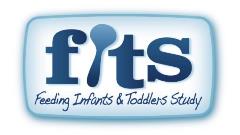The Feeding Infants and Toddlers Study (FITS) 2016

The Feeding Infants and Toddlers Study (FITS) is the largest cross-sectional dietary intake study in the United States focused on what and how children under the age of 4 eat.
Started in 2002, FITS 2016 marks the third FITS study completed, totaling nearly 10,000 parents and caregivers surveyed and about 50 peer-reviewed publications to date. The latest findings help uncover some areas where young children’s diets can be improved.
Featured FITS 2016 publication from the latest Journal of Nutrition Supplement: Regan L Bailey et al. Total Usual Nutrient Intakes of US Children (Under 48 Months): Findings from the Feeding Infants and Toddlers Study (FITS) 2016. The Journal of Nutrition (2018) 148 (suppl_3): 1557S-1566S
Background
The US Dietary Guidelines will expand in 2020 to include infants and toddlers. Understanding current dietary intakes is critical to inform policy.
Objective
The purpose of this analysis was to examine the usual total nutrient intakes from diet and supplements among US children.
Methods
The Feeding Infants and Toddlers Study 2016 is a national cross-sectional study of children aged <48 mo (n = 3235): younger infants (birth to 5.9 mo), older infants (6–11.9 mo), toddlers (12–23.9 mo), younger preschoolers (24–36.9 mo), and older preschoolers (36–47.9 mo) based on the use of a 24-h dietary recall. A second 24-h recall was collected from a representative subsample (n = 799). Energy, total nutrient intake distributions, and compliance with Dietary Reference Intakes were estimated with the use of the National Cancer Institute method.
Results
Dietary supplement use was 15–23% among infants and toddlers and 35–45% among preschoolers. Dietary intakes of infants were adequate, with mean intakes exceeding Adequate Intake for all nutrients except vitamins D and E. Iron intakes fell below the Estimated Average Requirement for older infants (18%). We found that 31–33% of children aged 12–47.9 mo had low percentage of energy from total fat, and >60% of children aged 24–47.9 mo exceeded the saturated fat guidelines. The likelihood of nutrient inadequacy for many nutrients was higher for toddlers: 3.2% and 2.5% greater than the Adequate Intake for fiber and potassium and 76% and 52% less than the Estimated Average Requirement for vitamins D and E, respectively. These patterns continued through older ages. Intakes exceeded the Tolerable Upper Intake Level of sodium, retinol, and zinc across most age groups.
Conclusions
Dietary intakes of US infants are largely nutritionally adequate; concern exists over iron intakes in those aged 6–11.9 mo. For toddlers and preschoolers, high intake of sodium and low intakes of potassium, fiber, and vitamin D and, for preschoolers, excess saturated fat are of concern. Excess retinol, zinc, and folic acid was noted across most ages, especially among supplement users.
To read the full paper:
https://academic.oup.com/jn/article/148/suppl_3/1557S/5026325
